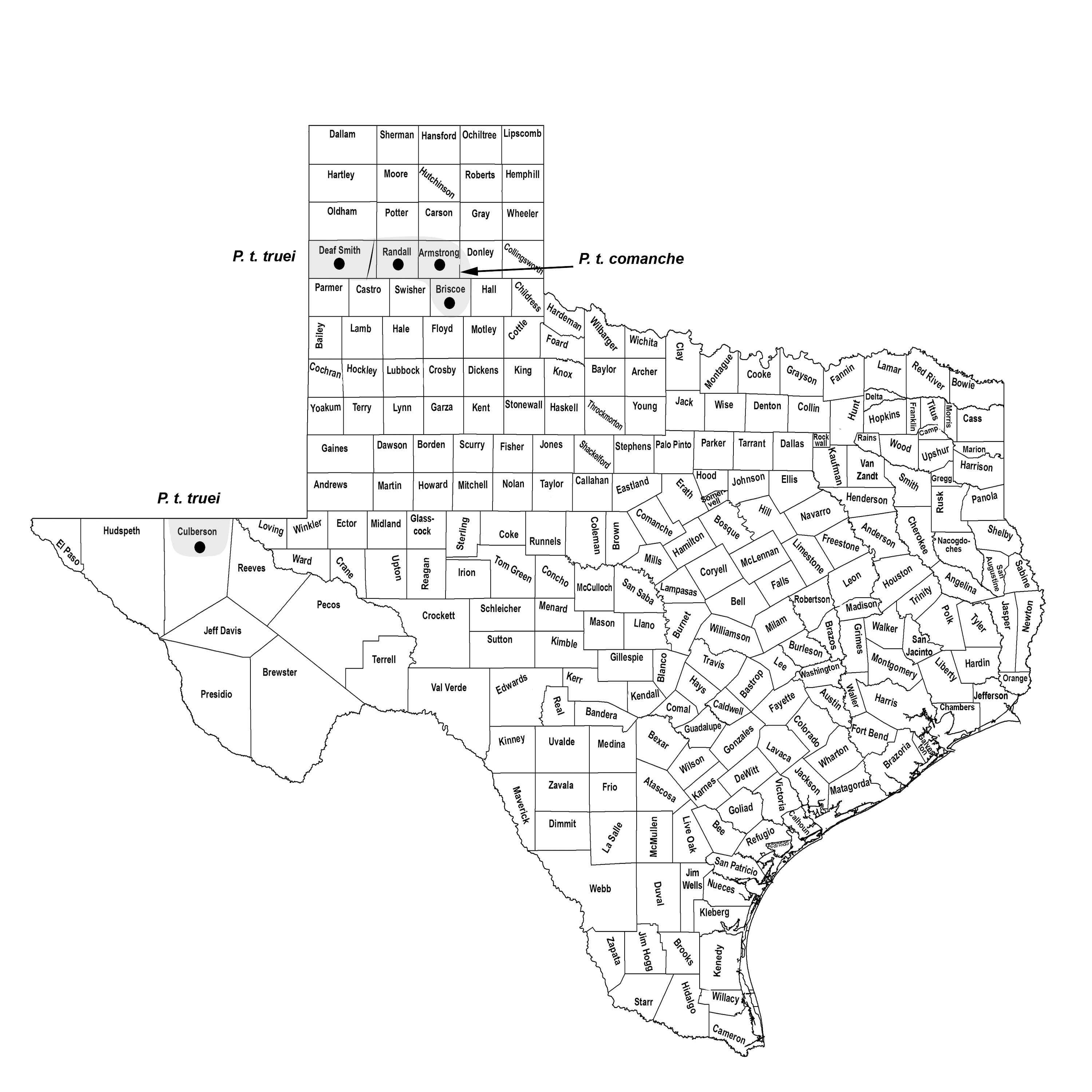PINON DEERMOUSE
Peromyscus truei (Shufeldt 1855)
Order Rodentia : Family Cricetidae
DESCRIPTION. A moderately sized, large-eared deermouse; tail as long as, or slightly longer than, head and body and scantily haired; upper parts ochraceous buff mixed with dusky, giving an overall effect of cinnamon or tawny olive in unworn pelage and wood brown in worn pelage; the pronounced lateral line is ochraceous buff; sides of face and nose grayish; ears dusky; feet and underparts white; tail dark above, white below. Dental formula: I 1/1, C 0/0, Pm 0/0, M 3/3 × 2 = 16. Averages for external measurements: total length, 204 mm; tail, 100 mm; hind foot, 22.5 mm; ear, 23.5 mm. Weight, 24–39 g.

DISTRIBUTION. In Texas, known in three distinct populations, one in the Guadalupe Mountains of Culberson County and two others, separated by approximately 120 km (75 mi.) of inhospitable habitat, from the northern breaks of the Llano Estacado.

SUBSPECIES. Peromyscus t. comanche, restricted to Palo Duro and adjacent canyons in Armstrong, Briscoe, and Randall counties, and P. t. truei, reaching its eastern distributional limit on the northwestern escarpment of the Llano Estacado in Deaf Smith County. Peromyscus t. truei also occurs in Guadalupe Mountains National Park in Culberson County of the Trans-Pecos.
HABITS. This species is restricted to rocky situations in cedar forests on canyon slopes and floors in the Palo Duro Canyon region. Areas in the juniper–mesquite association that have large, massive boulders seem to support the highest populations. Even so, intensive trapping produces few mice. In 1961, James Tamsitt (University of Texas) reported that in 1,803 trap-nights he captured only 25 specimens, a success ratio of 72 trap-nights per mouse caught. In Guadalupe Mountains National Park, the species is rarely found in the juniper and pinyon woodlands.
The food habits of these mice are not well known. In California, specimens examined in midsummer had been eating primarily insects and spiders, although by late summer their diet was predominantly acorn mast. In Colorado, the winter diet is primarily juniper berries.
Breeding habits are likewise poorly known. In 1997, Frank Yancey (Reedley College) studied a population in Briscoe County and found pregnant females in April, May, and October. An adult female with four embryos was captured on 24 July in the Guadalupe Mountains of the Trans-Pecos. These observations compare favorably with a breeding season from April through September in southwestern Colorado and February through November in Arizona. Litter size ranges from one to five, average three. At birth, the pups are hairless and the eyes and ears are closed. Between 2 and 3 weeks of age, the eyes and ears open. The body is haired by 2 weeks of age.
POPULATION STATUS. Uncommon. Both subspecies of the piñon deermouse are relatively rare in Texas. They are habitat specialists and therefore restricted in their distributions.
CONSERVATION STATUS. The IUCN lists the piñon deermouse as a species of least concern. It does not appear on the federal list, but the comanche subspecies is listed by TPWD as threatened. Although the piñon deermouse is not currently in direct danger from human activities, it easily could fall victim to a competing southern species in the region, P. attwateri, under a climate-change scenario in which mean annual temperature increased a degree or two. Elsewhere, the piñon deermouse is widespread and common in pinyon and yellow pine forests in western North America.
REMARKS. The Palo Duro Canyon population of P. truei has had a rather confusing taxonomic history. In 1943, Frank Blair recognized it as a new species in the P. truei group of mice and gave it the name P. comanche. In 1951, Donald Hoffmeister placed comanche as a subspecies of P. nasutus, and 10 years later he and Luis de la Torre transferred both nasutus and comanche to the largely Mexican species P. difficilis. In 1972, Raymond Lee and associates at the University of Illinois examined the karyotypes of comanche and found them to be identical with those of P. truei and markedly different from those of P. difficilis. Finally, in 1973, DJS reviewed P. comanche's systematic status and arranged it as a subspecies of P. truei. Recent DNA sequence studies by RDB and colleagues support this finding.
From The Mammals of Texas, Seventh Edition by David J. Schmidly and Robert D. Bradley, copyright © 1994, 2004, 2016. Courtesy of the University of Texas Press.
Natural Science Research Laboratory
-
Address
Museum of Texas Tech University, 3301 4th street, Lubbock, TX 79409 -
Phone
806.742.2486 -
Email
nsrl.museum@ttu.edu

